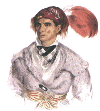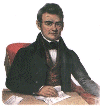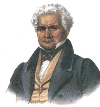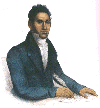 |
  |
| --click on the thumbnail to view the larger image -- |
|
 |
Joseph Vann, known as "Rich Joe", was a wealthy Cherokee whose large
plantation at Springplace GA was worked by hundreds of African slaves.
He was an ally of Chief John Ross and was a frequent delegate to Washington
DC on tribal business. He died in 1844 when his steamboat, the Lucy
Walker, exploded during a race on the Ohio River. |
|
 |
The Vann House at Springplace GA was built by James Vann and inherited
by his son Joseph "Rich Joe" Vann. In 1833, his mansion was confiscated
by Col. William Bishop of the Georgia Guard (militia) and the neighboring
Moravian mission school was turned into Georgia Guard headquarters. At
the time of removal, Rich Joe's property valuation showed him as the second
richest man in the Nation. |
|
 |
The Cherokee national newspaper, The Cherokee Phoenix, was first
printed February 21, 1828 at New Echota (near present Calhoun, GA) with
Elias Boudinot (i.e., Buck Oowatie) as editor. The paper was printed in
both Cherokee and English and became popular in the United States and Europe.
Boudinot, prominent in the "pro-removal" faction of the tribe, resigned
as editor, apparently a result of friction with Chief John Ross over the
removal issue. Boudinot was one of three Treaty Party leaders assasinated
in 1839 for signing the Treaty of New Echota. The paper ceased publication
in May, 1834. |
|
 |
Tah-chee or "Dutch" was a Western Cherokee chief who refused to move
from Arkansas to the Indian Territory and took his group to settle in east
Texas. The Texas Cherokees were forced to move to Indian Territory after
a bloody battle with the army of the Republic of Texas in the 1840's. |
|
 |
John Ross was principal chief of the Eastern Cherokees and later the
combined Cherokee Nation in Indian Territory. He served from 1828 until
his death in 1866. Ross was 1/8 Cherokee by blood. Although allied with
the Confederacy in the American Civil War, Ross allowed himself to be captured
without incident by Union troops in 1862 and moved to Philidelphia where
he lived until the end of the war. |
|
 |
Kah-nung-da-tla-geh, "the man who walks the mountain top", was know
as "The Ridge" and later Major Ridge, for his participation in the Creek
War 1813-1814. He was the leader of the Ridge or Treaty Party. His brother,
Oo-wa-tie, "the ancient one", was the father of Stand Watie. He served
as head of the Lighthorse Guard (i.e., Cherokee police), member of the
National Committee, and speaker of the National Council. The valuation
of his property at the time of the removal west showed him to be the third
richest man in the Cherokee Nation. He was assasinated in 1839 for signing
the Treaty of New Echota for removal of the Cherokees to the West. |
|
 |
John Ridge was the son of The Ridge. He was also assasinated in 1839
for signing the Treaty of New Echota. |
|
 |
The forced removal of the Cherokee in 1838-39 from their homelands
in the east to Indian Territory (now Oklahoma) is known as the "Trail of
Tears" or "The Trail Where They Cried". Of the 16,000 Cherokees who were
herded into stockades and marched west by U.S. troops, about 4,000 died
of desease, exposure, or fatigue. A U.S. soldier, John Burnett, recalled
in later years, "I saw the helpless Cherokees arrested and dragged from
their homes, and driven by bayonet into stockades. And in the chill of
a drizzling rain on an October morning I saw them loaded like cattle or
sheep into six hundred and forty-five wagons and started toward the west" |
|
  Copyright © Ken Martin, 1996
Copyright © Ken Martin, 1996
|








